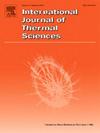Effects of effusion hole configuration on liner wall cooling effectiveness and combustion performance in a can-type combustor model
IF 4.9
2区 工程技术
Q1 ENGINEERING, MECHANICAL
International Journal of Thermal Sciences
Pub Date : 2025-07-16
DOI:10.1016/j.ijthermalsci.2025.110150
引用次数: 0
Abstract
Effusion cooling is a widely adopted technique for managing high-temperature environments in aviation and various industrial applications. This method involves directing cooling air over component surfaces to protect critical engine parts from thermal damage, enhancing durability, improving efficiency, and reducing thermal emissions. This study used different configurations of effusion cooling holes on the liner wall of a can-type combustor model to evaluate their effects on cooling and combustion performances. Numerical simulations were conducted using ANSYS Fluent 2024 R1, with the turbulence and combustion of methane fuel modeled using the Reynolds Stress Model and the steady flamelet approach of the nonpremixed combustion model. The simulation results revealed that effusion holes oriented at a tangent angle of 0° significantly enhanced liner wall cooling effectiveness by approximately 340.28 %. This configuration obstructed 77.71 % of the absorbed radiative heat flux, which led to a 47.81 % reduction in wall temperature. This improvement was attributed to the diminished strength of the dilution hole jets, which resulted in incomplete combustion, as evidenced by the mixture distribution and OH mole fraction profiles. Consequently, direct quenching effects were observed on the flame front in the secondary and dilution regions, resulting in an approximately 5.56 % reduction in combustion efficiency. Moreover, the lowest pattern factor value was obtained when designing the liner wall with effusion holes at a tangent angle of ±30°, compared to other effusion hole configurations. Similarly, injecting cooling air into the combusted flame through an effusion hole at a tangent angle of 0° resulted in a reduction of approximately 20.23 % in the thermal NOx emissions.
射流孔构型对罐式燃烧室壁面冷却效果和燃烧性能的影响
在航空和各种工业应用中,射流冷却是一种被广泛采用的高温环境管理技术。这种方法包括将冷却空气引导到部件表面,以保护关键的发动机部件免受热损伤,增强耐用性,提高效率,并减少热排放。本研究采用不同配置的射流冷却孔在罐式燃烧室模型的内壁上,评估其对冷却和燃烧性能的影响。采用ANSYS Fluent 2024 R1软件对甲烷燃料湍流和燃烧过程进行了数值模拟,采用雷诺应力模型和非预混燃烧模型的稳定火焰方法对甲烷燃料湍流和燃烧过程进行了模拟。模拟结果表明,切角为0°的射流孔能显著提高管壁冷却效率,提高幅度约为340.28%。这种结构阻挡了77.71%的吸收辐射热通量,使壁面温度降低了47.81%。这种改善归因于稀释孔射流强度的降低,这导致了不完全燃烧,混合物分布和OH摩尔分数曲线证明了这一点。因此,在二次区和稀释区火焰前缘观察到直接淬火效应,导致燃烧效率降低约5.56%。此外,与其他射流孔配置相比,当射流孔的正切角为±30°时,射流壁的图案因子值最低。同样,通过一个相切角为0°的射流孔向燃烧的火焰注入冷却空气,可使NOx的热排放减少约20.23%。
本文章由计算机程序翻译,如有差异,请以英文原文为准。
求助全文
约1分钟内获得全文
求助全文
来源期刊

International Journal of Thermal Sciences
工程技术-工程:机械
CiteScore
8.10
自引率
11.10%
发文量
531
审稿时长
55 days
期刊介绍:
The International Journal of Thermal Sciences is a journal devoted to the publication of fundamental studies on the physics of transfer processes in general, with an emphasis on thermal aspects and also applied research on various processes, energy systems and the environment. Articles are published in English and French, and are subject to peer review.
The fundamental subjects considered within the scope of the journal are:
* Heat and relevant mass transfer at all scales (nano, micro and macro) and in all types of material (heterogeneous, composites, biological,...) and fluid flow
* Forced, natural or mixed convection in reactive or non-reactive media
* Single or multi–phase fluid flow with or without phase change
* Near–and far–field radiative heat transfer
* Combined modes of heat transfer in complex systems (for example, plasmas, biological, geological,...)
* Multiscale modelling
The applied research topics include:
* Heat exchangers, heat pipes, cooling processes
* Transport phenomena taking place in industrial processes (chemical, food and agricultural, metallurgical, space and aeronautical, automobile industries)
* Nano–and micro–technology for energy, space, biosystems and devices
* Heat transport analysis in advanced systems
* Impact of energy–related processes on environment, and emerging energy systems
The study of thermophysical properties of materials and fluids, thermal measurement techniques, inverse methods, and the developments of experimental methods are within the scope of the International Journal of Thermal Sciences which also covers the modelling, and numerical methods applied to thermal transfer.
 求助内容:
求助内容: 应助结果提醒方式:
应助结果提醒方式:


